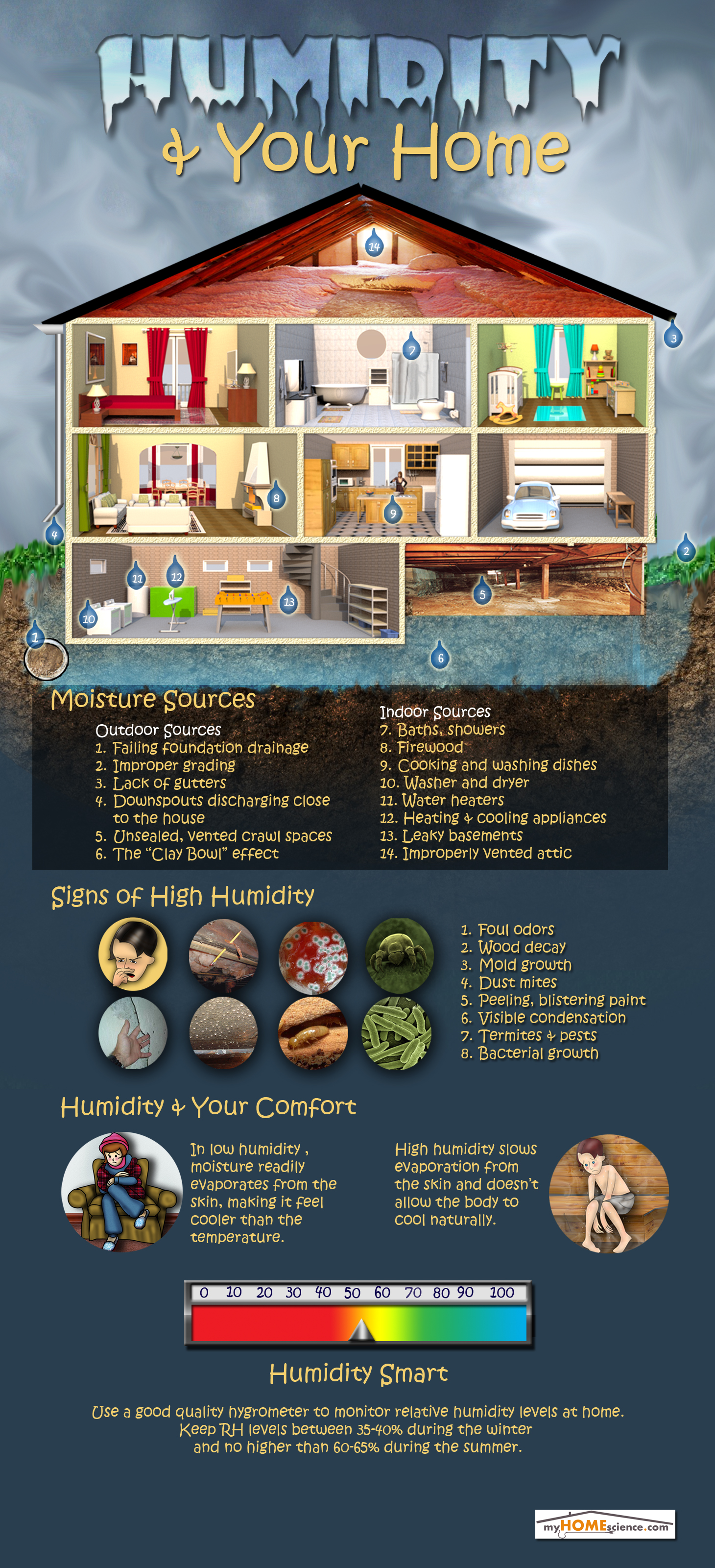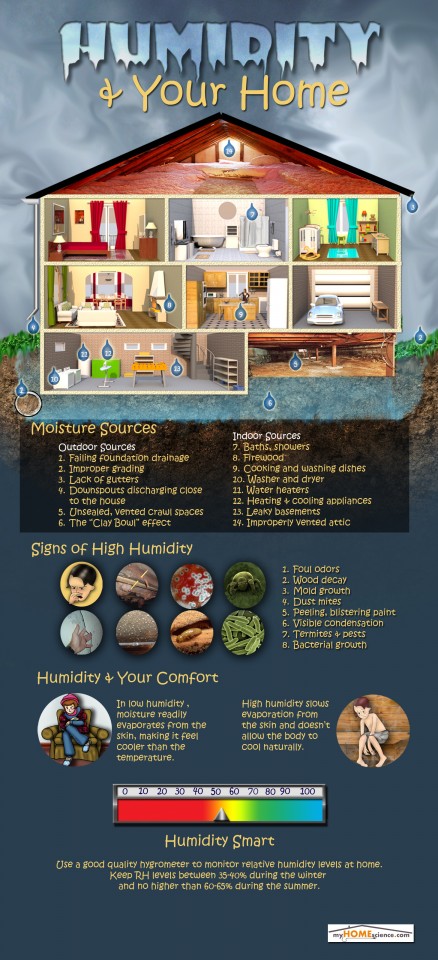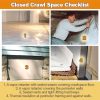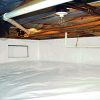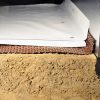High humidity on a hot summer day makes us feel warmer than what the thermometer reads. In fact, when the temperature reaches 90° F. and the relative humidity (RH) is 80%, it feels like 117 degrees F! This happens because high humidity slows evaporation from the skin and doesn’t allow the body to cool naturally. The same temperature with an RH of 40% feels like 85° F. By lowering the relative humidity inside your home, it’s possible to improve comfort without relying on air conditioning (or at least not so much of it).
Low humidity does the reverse. Moisture readily evaporates from the skin, making it feel cooler than the temperature. If the indoor temperature is 68° F. and the RH is 30%, the “apparent” temperature is 64° F. At the same temperature but with a relative humidity of 60%, the temperature feels three degrees warmer. Maintaining adequate humidity in winter allows you to dial down the thermostat, save on your fuel bill, and still maintain comfort. Strategies for maintaining adequate humidity include houseplants, drying clothing on an indoor clothesline, and leaving water in the tub after a shower.
It’s important, however, not to allow humidity levels to get too low or too high. Very low relative humidity is a potential health hazard. It can cause respiratory ailments, nosebleeds, and dehydration. High humidity causes poor indoor air quality. Viruses, bacteria, dust mites (the number one allergen), and fungal populations flourish.
So why isn’t there a hygrometer in every home?
Despite the profound effects humidity has upon comfort and wellbeing, few homeowners have a convenient way to measure levels in our homes. While we all have the thermometer in the thermostat that controls the furnace, hygrometers are not very common.
Peter Yost, a building scientist at buildinggreen.com who speaks and teaches widely upon the subjects like this one, agrees that humidity levels deserve more attention. “A big pet peeve of mine,” says Yost, “is that a decent electronic hygrometer is not routinely built into t-stats [thermostats]. They are available but generally only on fancy and expensive controls that are part of a system that humidifies forced-air systems.”
If you decide to monitor humidity levels in your home, Yost says it’s important to buy an accurate hygrometer. “You can’t get a decent one for under $20,” says Yost. “Ideally, buy one with an RH accuracy rating of plus or minus 2 or 3.”
Place your hygrometer in a room that will give you a representative reading for the whole house. A family room or living room, away from exterior walls and major sources of moisture, would be a good choice. Regularly move the hygrometer to rooms of concern, such as the basement, kitchen, and bedrooms when occupied and with the door(s) closed, advises Yost.
“From 30 to 60% people have a hard time guessing the RH. That’s a pretty big range to be in the dark.” – Peter Yost, buildinggreen.com
How humidity is measured
To use a hygrometer, it’s import to understand what is meant by relative humidity. In layman’s terms, it’s the water vapor air contains compared to the maximum amount of moisture it could contain at a given temperature. This explains why you don’t need a snorkel when the humidity is 100%. An RH of 50% at 80° F means that the air contains half the maximum amount of water vapor it can contain at that temperature. An RH of 100% holds all the water it can possibly hold. Decrease the temperature by one degree and condensation will occur.
As the temperature changes, so does the amount of water vapor air it can hold. The warmer it gets, the greater its capacity to contain water vapor. At 100 % RH with an air temperature of 86° F, a cubic meter of air contains 30.4 grams of water. An RH of 100% at 68° F. contains only 17.3 grams per cubic meter. In other words, in winter when the RH in your home is low, a cubic meter of air might only contain 4 or 5 grams of water vapor. In summer, it probably contains 4 or 5 times that much.
“People tend to overdo it when it comes to humidification. It doesn’t make sense to improve humidity levels but to end up with a mold problem.” – Peter Yost, buildinggreen.com
Recommended humidity levels
In winter the minimum for human comfort is generally 30% RH says Yost. “Below this level, static electricity and drying nasal membranes and eyes become issues. Buildings would generally prefer lower wintertime RH (25% or even 20% in cold and really cold climates), but humans don’t go for this.”
The EPA states that adequate wintertime humidity levels can be maintained without the use of humidifiers if your home was built using energy-efficient construction details and has been carefully air-sealed. If not, humidification may be required to maintain adequate relative humidity and comfort. It is important, however, to avoid over-humidification. It can lead water condensation on cold surfaces, like windows and attic framing.
New low-maintenance, whole-house dehumidifiers help with moisture control. They include controls that automatically regulate humidity by sensing moisture content in the return air stream. They even factor in outside temperatures. As temperatures drop outside, so do the recommended indoor relative humidity levels. This helps reduce the chance of excessive condensation. It’s also important to have your home air-sealed as soon as possible.
In summer, when high relative humidity is a danger, many homeowners run dehumidifiers in the basement. Doing so will help control humidity throughout the house. Peter Yost recommends setting the dehumidifier’s humidistat as high as you can before indoor air quality issues, like mold spore proliferation, kick in. There’s no sense spending money removing more water from the air than you need to. “In my basement,” says Yost, “somewhere between 60 and 65% RH is what I can get away with. Most folks would say that going as high as 65 is pushing it, but I actively monitor basement RH — not with the highly inaccurate RH setting on the dehumidifier but with a separate electronic quality hygrometer.”
A high-capacity, low-maintenance dehumidifier, such as Sani-Dry, is critical for efficiency and long-term performance. It comes in models designed for both basements and crawlspaces.
Not going to invest in a good hygrometer? You can get a pretty good idea of whether your home has excessive humidity by visiting a closet on the north wall, says Yost. “It will have no sun, dead air, and probably something made of leather, a favorite food for mold. If there is no evidence of mold or mildew, it’s a pretty good sign that you’re okay.”

